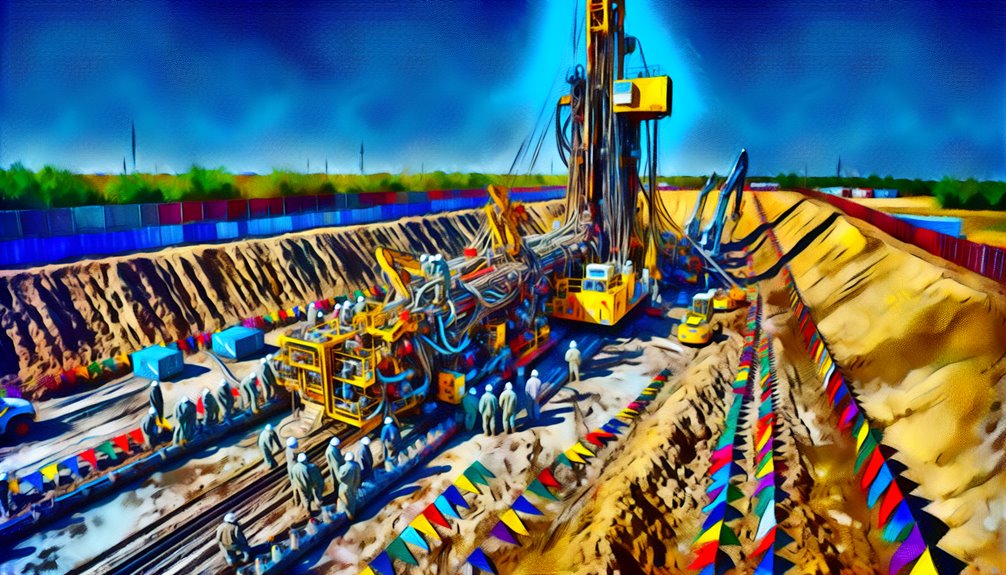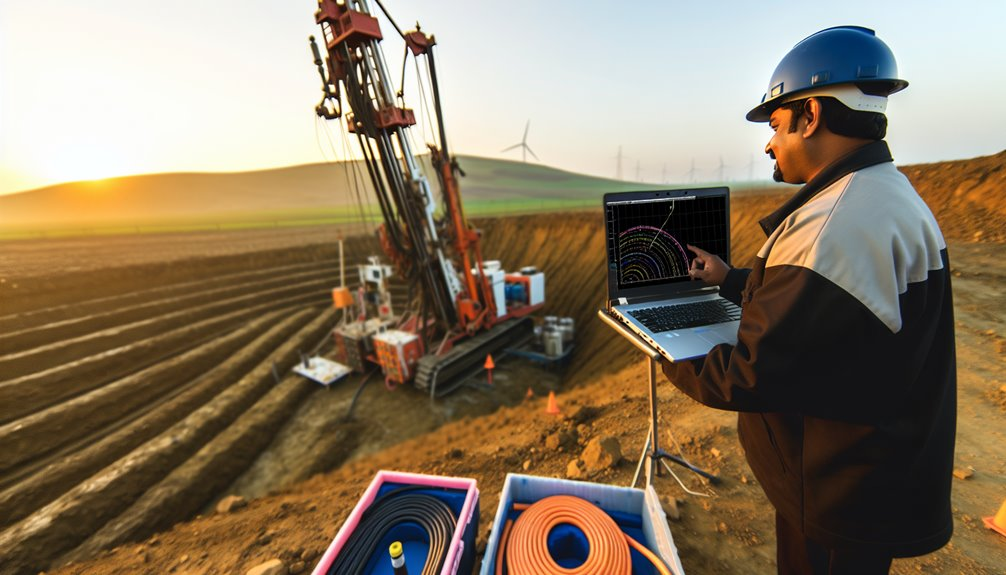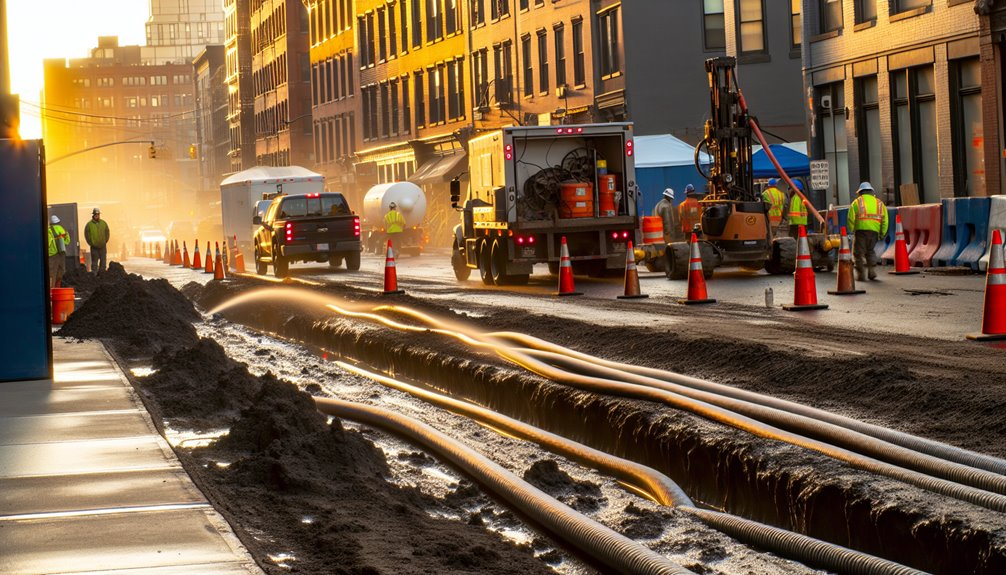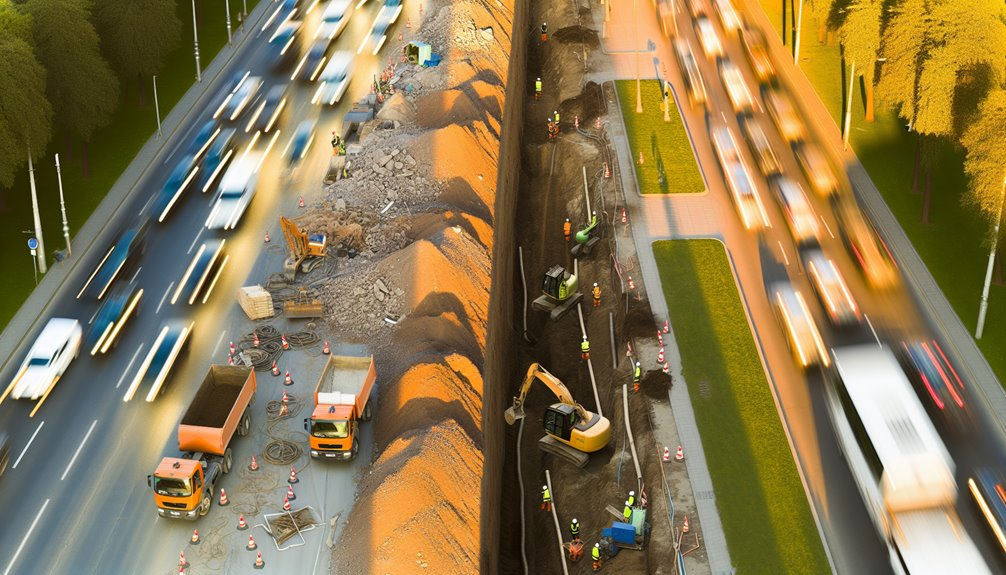In exploring the success stories of Horizontal Directional Drilling (HDD), you'll find that this technique not only minimizes environmental impact but also offers precise, controlled installation under rivers, buildings, and busy urban areas. Consider the Thames Water Ring Main Extension, where HDD navigated London's complex subterranean landscape, avoiding significant surface disruption. This case, among others, highlights HDD's strategic role in modern infrastructure projects. Discover how these innovations could reshape your understanding of urban and environmental engineering.
The Thames Water Ring Main Extension: Overcoming London's Underground
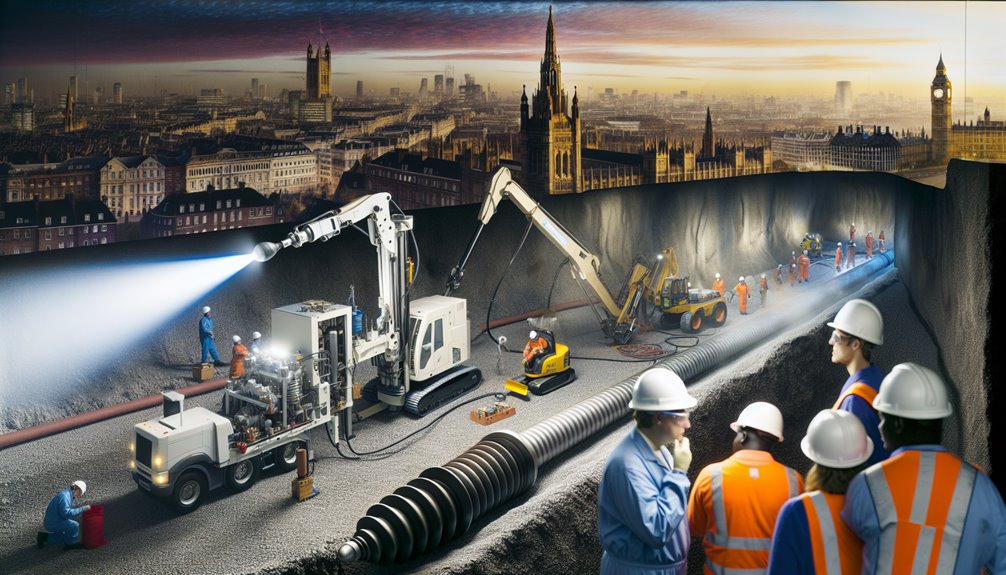
While constructing the Thames Water Ring Main, engineers tackled the challenging London Clay and more problematic Thanet Sand beneath London's bustling streets.
You'll appreciate the precision required in tunnel construction, where consistent adaptation was critical. The use of tunnel boring machines and interlocking wedgelock linings was a pivotal strategy, ensuring the structural integrity of the tunnels through varied geological layers.
Dealing with the highly abrasive Thanet Sand, which compromised equipment due to its high permeability and presence in the water table, required innovative approaches.
These adaptations not only facilitated the water supply to millions but also exemplified cutting-edge engineering solutions in an urban underground environment, showcasing a remarkable achievement in maintaining and enhancing London's infrastructure resilience. The introduction of Earth Pressure Balance Machines (EPBMs) enhanced control of the difficult ground conditions, setting new standards for tunneling technology in the region.
The Yangtze River Crossing: A Milestone in Chinese Infrastructure
You'll find that the Yangtze River Crossing project's engineering challenges were formidable, involving the management of seismic risks and complex geological conditions like liquefied soil and shallow gas. By successfully deploying dual mixed Tunnel Boring Machines and innovative tunneling techniques, the project not only maintained structural integrity but also guaranteed safety under extreme conditions. This infrastructure achievement has greatly boosted the local economy by enhancing connectivity and reducing travel time, thereby accelerating economic growth in the Yangtze River Delta. Additionally, the bridge's innovative design, featuring a three-tower cable-stayed structure, significantly reduces construction materials and timelines.
Engineering Challenges Overcome
Despite facing significant technical challenges, engineers achieved a remarkable feat with the Yangtze River Crossing project, setting a benchmark in Chinese infrastructure.
You'll appreciate the precision in calculating the scour depth vital for determining pipeline integrity. This was essential to guarantee the pipeline was buried deep enough to withstand sediment instability and protect the pipeline's exterior coating from abrasive fine sands prevalent in the Yangtze's bed.
Intersect drilling techniques minimized the risks associated with long traverses through soft sediments, cleverly halving the drilling distance and reducing the chances of the drill getting stuck—a frequent risk in such vast and complex undertakings.
The use of advanced drilling rigs guaranteed that each phase met stringent accuracy requirements, critical for maintaining the project's ambitious timeline.
Impact on Local Economy
As the Yangtze River Crossing project reached completion, it catalyzed significant economic growth within the region, underscoring its role as a pivotal milestone in Chinese infrastructure development.
You're witnessing a transformative era where strategic infrastructure elevates local development to new heights.
Here's how this engineering marvel is reshaping the economic landscape:
- Enhanced Connectivity: Boosts intra-regional trade and access to global markets, propelling the local economy.
- Industrial Upturn: Attracts multinational corporations, fostering high-tech and industrial district expansions.
- Employment Opportunities: Creation of jobs across sectors, reducing local unemployment.
- Regional Equity: Improves transportation cost accessibility, strengthening economic ties and equity across cities.
You're at the forefront of an era where such advancements not only drive economic growth but redefine living standards.
The Los Angeles Power Line Expansion: HDD in Urban Settings
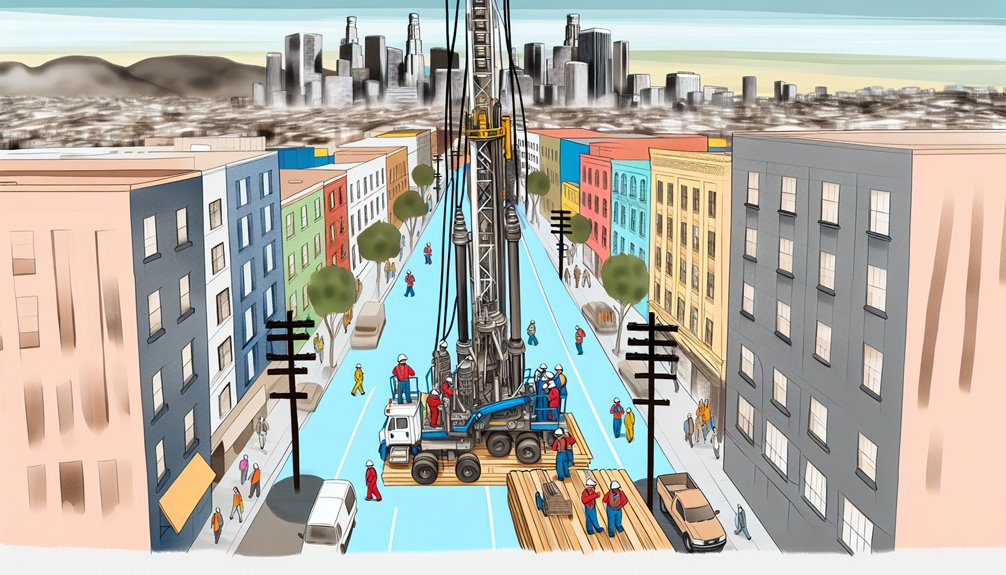
To effectively accommodate the surge in renewable energy resources, the Los Angeles Department of Water and Power (LADWP) is upgrading the McCullough–Victorville Transmission Lines.
You'll find that Horizontal Directional Drilling (HDD) plays a vital role in this project, particularly in urban excavation and utility installation. This trenchless method minimizes surface disruption, a significant advantage in densely populated areas.
By deploying HDD, LADWP guarantees that the enhanced transmission lines are installed efficiently, bypassing the challenges of traditional trenching. This approach not only accelerates the project timeline but also greatly reduces environmental impact.
Furthermore, HDD's ability to install utilities at greater depths enhances infrastructure security, essential in urban settings where existing networks are dense.
The Amazon Rainforest Fiber Optic Installation: Preserving Biodiversity
You'll find that the Amazon Rainforest Fiber Optic Installation employs horizontal directional drilling (HDD) to greatly reduce its ecological footprint.
This method integrates advanced technologies that precisely navigate beneath the Amazon River, avoiding widespread disruption of the delicate terrestrial ecosystem.
These efforts guarantee long-term connectivity benefits for over 500,000 users while simultaneously preserving the region's biodiversity.
Minimizing Ecological Footprint
When installing fiber optic cables in the Amazon Rainforest, employing Horizontal Directional Drilling (HDD) greatly minimizes the ecological footprint, fundamental for preserving the region's rich biodiversity.
HDD's precise technology allows you to deploy sustainable methods effectively, focusing on environmental preservation at every step.
Key Benefits of HDD in the Amazon:
- Root Structure Integrity: HDD prevents the destruction of essential plant root systems, critical for maintaining forest stability.
- Habitat Preservation: Reduces disturbance to burrowing animal habitats, ensuring their survival and continuity.
- Invasive Species Control: Limits equipment contamination, preventing the spread of invasive plant seeds.
- Soil Structure Maintenance: Avoids compaction, preserving soil infiltration rates and supporting overall ecosystem health.
Advanced Technology Integration
Integrating advanced technology in the installation of fiber optic cables within the Amazon Rainforest not only preserves its biodiversity but also enhances operational efficiency and compliance with stringent environmental standards.
Utilizing Horizontal Directional Drilling (HDD), you can install infrastructure with minimal ecological disruption. This precise drilling technology allows for the placement of high-performance, environmentally friendly cables that meet rigorous international standards.
The use of trenchless methods and armored cables guarantees that the delicate river ecosystems are undisturbed, while maintaining the natural habitat above. Additionally, this approach adheres to the highest criteria for cable sustainability, essential for protecting the rainforest.
Long-term Connectivity Benefits
As Horizontal Directional Drilling (HDD) minimizes surface disruption, it plays an essential role in preserving the Amazon Rainforest's biodiversity while establishing long-term connectivity benefits.
This innovative approach not only protects the ecological balance but also paves the way for future generations to benefit from sustainable development and enhanced community empowerment.
- Advanced Monitoring: Real-time, thorough ecosystem data through fiber-connected sensors and satellite integration.
- Economic Opportunities: Sustainable economic growth for local communities via data-driven eco-tourism and conservation projects.
- Ecological Integrity: Maintained biodiversity and forest ecosystem functions, reducing deforestation and habitat fragmentation.
- Empowered Communities: Real-time environmental data and tools foster informed decision-making and proactive conservation efforts.
The Brisbane River Pipeline Installation: Mitigating Flood Risks
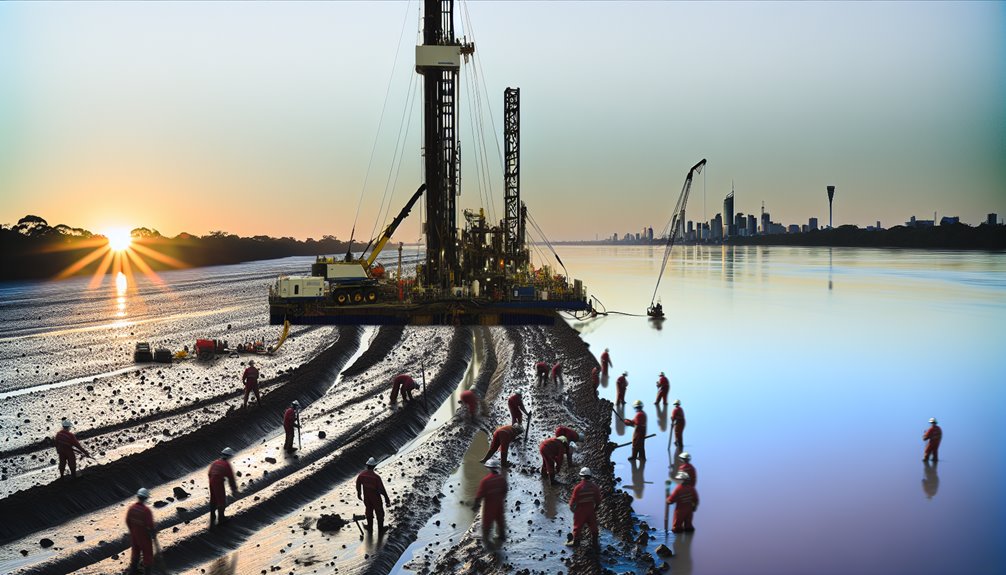
To further mitigate flood risks in the Brisbane River catchment, the installation of a new pipeline using Horizontal Directional Drilling (HDD) technology represents a critical advancement.
This strategic approach not only enhances flood resilience but also minimizes environmental disruption. Utilizing HDD allows for precise underground placement of pipelines, bypassing the need for extensive surface excavation that can alter water flow and exacerbate flood conditions.
The integration of this technology aligns with the sophisticated hydraulic modelling outcomes from the Brisbane River Catchment Flood Study. By embedding the pipeline deep beneath the flood-prone zones, you're safeguarding infrastructure against potential damages and ensuring continuity in utility services during flood events, a proactive step in thorough floodplain management.
The Arctic Circle Oil Pipeline: Challenges and Innovations
While the Brisbane River Pipeline installation employs Horizontal Directional Drilling to enhance flood resilience in Australia, a quite different application of pioneering construction techniques can be seen in the Arctic Circle.
You'll find that the Trans-Alaska Pipeline System incorporates advanced innovations tailored to its unique environment.
- Permafrost Management: Utilization of elevated structures to mitigate heat transfer from hot oil to the frozen ground.
- Oil Leakage Prevention: Installation of 178 valves and rigorous monitoring systems guarantee minimal environmental impact.
- Wildlife Conservation: Design allows animal migration with minimal disruption, aligning with environmental conservation goals.
- Heat Dissipation Devices: Strategically placed to maintain permafrost integrity around critical support structures.
These features showcase how technical ingenuity meets environmental stewardship in one of the most challenging terrains on Earth.
Conclusion
You've observed how Horizontal Directional Drilling (HDD) not only addresses complex engineering challenges but also harmonizes with environmental imperatives. From London's subterranean complexities to the delicate ecosystems of the Amazon, HDD demonstrates its versatility and minimal invasive impact. Whether mitigating urban congestion or preserving biodiverse habitats, HDD's strategic application underscores its pivotal role in sustainable infrastructure development, proving essential for both robust urban expansion and ecological conservation.
If you're curious to dive deeper into the world of HDD and see how it can benefit your projects, I invite you to visit Boring Bros at boringbro.com. Our team is always ready to help, so feel free to give us a call at (954) 639-6167. We're excited to share our expertise with you and discuss how we can make your infrastructure needs a reality!

